Tree and Shrub Problems - Disease

When you notice a problem with a deciduous tree or shrub, it is often difficult to tell at first glance if the problem is caused by a disease, an insect, or the environment. The important thing is to not jump to conclusions; a wrong diagnosis will not help your plant, and may even make the problem worse. A little time spent gathering information about the tree or shrub, and about where it is planted will help you to unravel some of the complexities of plant diagnosis. The key to successful diagnosis in plants is to be patient and never assume anything:
First and foremost, what kind of plant do you have? Many diseases affect only specific trees and shrubs, so knowing the plant narrows the field of possible problems. Know what a healthy example of this plant looks like, and what the cultural requirements are for successfully growing it.
Next, write down any information on cultural practices, weather conditions, and pesticides, fertilizers, and weed killer applications that occurred before and during the development of the symptoms. Along with this information, detail the physical characteristics of the site where the tree or shrub is planted. How old is the plant? What is the soil type? The drainage? Recent construction? Near the street? How often and how much do you water? Does the site provide protection from wind? Or is it fully exposed. How much sun does the plant receive each day, or is it mostly in the shade. After assessing the most recent conditions, think back to last year, or the year before, did anything out of the ordinary happen to the tree or shrub then? Sudden changes in temperature? Ice storms? Early or late freezes?
Now, take a look at the entire plant and the area surrounding it. Is only this tree or shrub affected, or does other plant material (including same species trees or shrubs) exhibit the same symptoms.
Where does the problem appear on the tree or shrub? All on one side? Only at the top? At the bottom only? Is the entire plant affected? The distribution of the problem is important in distinguishing between environmental problems, insect problems or chemically induced problems.
Next, inspect the plant carefully in order to list the specific symptoms of the problem, and list everything unusual you see. You should inspect the trunk, leaves (upper and lower surfaces), branches, roots; look for leaf spots, insects feeding, cankers, galls, decay, wilting, sap running, wounds, unusual leaf formations, cupping of leaves, either upwards or downward
Next, consult reliable sources, and compare your information with descriptions of problems known to occur on your plant.
Tree and Shrub Problems - Wasps

When someone mentions wasps, you usually think of a social wasp, like a yellowjacket. But there are many types of wasps that are solitary, i.e. they live by themselves. A large, common group of solitary wasps are sphecid (SFEE-sid) wasps. They have been frequently observed during August.
This is quite a varied and interesting group of insects. Some species are just a fraction of an inch while others can be over an inch and half long. Although they live by themselves, some nest close to each other in nonsocial groups. Many sphecid wasps nest in the ground. Others nest above ground in cavities, such as in twigs or crevices, or in nests constructed of mud.
Sphecid wasps prey on other insects and spiders. They paralyze insects to feed to their young. They either drag the immobilized insects back to their nests or carry them while flying back. A particular sphecid wasp species usually attacks a specific type of insect.
Although sphecid wasps can sting, they are generally not aggressive towards people and mind their own business if they are left undisturbed. If their nests do not pose any threat, then leave them alone and they will go away on their own by the end of the summer. If there is concern about stings from a ground nest, pour soapy water into it. Use a ‘wasp and hornet' spray if there is a troublesome above ground nest.
Tree and Shrub Problems - Mites

Spider mites are common pest problems on many plants around yards and gardens in North America. Injury is caused as they feed, bruising the cells with their small, whiplike mouthparts and ingesting the sap. Damaged areas typically appear marked with many small, light flecks, giving the plant a somewhat speckled appearance.
Following severe infestations, leaves become discolored, producing an unthrifty gray or bronze look to the plant. Leaves and needles may ultimately become scorched and drop prematurely. Spider mites frequently kill plants or cause serious stress to them.
Spider mites (Family: Tetranychidae) are classed as a type of arachnid, relatives of insects that also includes spiders, ticks, daddy-longlegs and scorpions. Spider mites are small and often difficult to see with the unaided eye. Their colors range from red and brown to yellow and green, depending on the species of spider mite and seasonal changes in their appearance.
Many spider mites produce webbing, particularly when they occur in high populations. This webbing gives the mites and their eggs some protection from natural enemies and environmental fluctuations. Webbing produced by spiders, as well as fluff produced by cottonwoods, often is confused with the webbing of spider mites.
The most important spider mite is the twospotted spider mite (Tetranychus urticae). This mite attacks a wide range of garden plants, including many vegetables (e.g., beans, eggplant), fruits (e.g., raspberries, currants, pear) and flowers. The twospotted spider mite is also the most important species on house plants. It is a prolific producer of webbing.
Evergreens tend to host other mites, notably the spruce spider mite (Oligonychus ununguis) on spruce and juniper, Oligonychus subnudus on pines, and Platytetranychus libocedri on arborvitae and juniper. Honeylocust, particularly those in drier sites, are almost invariably infested with the honeylocust spider mite (Platytetranychus multidigituli). Other mites may affect shade trees such as elm, mountain ash and oak.
Another complex of mites is associated with turfgrass, including the clover mite and Banks grass mite. These are discussed separately in fact sheet 5.505, Clover and Other Mites of Turfgrass. Clover mites also are the common mite that enters homes in fall and spring, sometimes creating significant nuisance problems in the process.
Life History and Habits
Spider mites develop from eggs, which usually are laid near the veins of leaves during the growing season. Most spider mite eggs are round and extremely large in proportion to the size of the mother. After egg hatch, the old egg shells remain and can be useful in diagnosing spider mite problems.
There is some variation in the habits of the different mites that attack garden plants, trees and shrubs. Outdoors, the twospotted spider mite and honeylocust spider mite survive winter as adults hidden in protected areas such as bark cracks, bud scales or under debris around the garden. Other mites survive the cool season in the egg stage. As winter approaches, most mites change color, often turning more red or orange. This habit may be why they are sometimes called "red spiders."
Most spider mite activity peaks during the warmer months. They can develop rapidly during this time, becoming full-grown in as little as a week after eggs hatch. After mating, mature females may produce a dozen eggs daily for a couple of weeks. The fast development rate and high egg production can lead to extremely rapid increases in mite populations.
Other species of spider mites are most active during the cooler periods of the growing season, in spring and fall. This includes the spruce spider mite and most of the mites that can damage turfgrass. These cool-season spider mites may cease development and produce dormant eggs to survive hot summer weather.

Dry conditions greatly favor all spider mites, an important reason why they are so important in the more arid areas of the country. They feed more under dry conditions, as the lower humidity allows them to evaporate excess water they excrete. At the same time, most of their natural enemies require more humid conditions and are stressed by arid conditions. Furthermore, plants stressed by drought can produce changes in their chemistry that make them more nutritious to spider mites.
Biological Controls
Various insects and predatory mites feed on spider mites and provide a high level of natural control. One group of small, dark-colored lady beetles known as the "spider mite destroyers" (Stethorus species) are specialized predators of spider mites. Minute pirate bugs, big-eyed bugs (Geocoris species) and predatory thrips can be important natural enemies.
A great many mites in the family Phytoseiidae are predators of spider mites. In addition to those that occur naturally, some of these are produced in commercial insectaries for release as biological controls. Among those most commonly sold via mail order are Galendromus occidentalis, Phytoseiulus persimilis, Mesoseiulus longipes and Neoseiulus californicus. Although these have been successful in control of spider mites on interior plants, effective use outdoors has not been demonstrated in Colorado. Predatory mites often have fairly high requirements for humidity, which can be limiting. Most suppliers provide information regarding use of the predator mites that they carry.
One reason that spider mites become problems in yards and gardens is the use of insecticides that destroy their natural enemies. For example, carbaryl (Sevin) devastates most spider mite natural enemies and can greatly contribute to spider mite outbreaks. Malathion can aggravate some spider mite problems, despite being advertised frequently as effective for mite control. Soil applications of the systemic insecticide imidacloprid (Merit, Marathon) have also contributed to some spider mite outbreaks.
Water Management
Adequate watering of plants during dry conditions can limit the importance of drought stress on spider mite outbreaks. Periodic hosing of plants with a forceful jet of water can physically remove and kill many mites, as well as remove the dust that collects on foliage and interferes with mite predators. Disruption of the webbing also may delay egg laying until new webbing is produced. Sometimes, small changes where mite-susceptible plants are located or how they are watered can greatly influence their susceptibility to spider mite damage.
Chemical Controls
Chemical control of spider mites generally involves pesticides that are specifically developed for spider mite control (miticides or acaricides). Few insecticides are effective for spider mites and many even aggravate problems. Furthermore, strains of spider mites resistant to pesticides frequently develop, making control difficult. Because most miticides do not affect eggs, a repeat application at an approximately 10- to 14-day interval is usually needed for control. Table 1 includes a summary of pesticides that may be useful for managing spider mites.
Capitalise on low hanging fruit to identify a ballpark value added activity to beta test. Override the digital divide with additional clickthroughs from DevOps. Nanotechnology immersion along the information highway will close the loop on focusing solely on the bottom line.
Podcasting operational change management inside of workflows to establish a framework. Taking seamless key performance indicators offline to maximise the long tail. Keeping your eye on the ball while performing a deep dive on the start-up mentality to derive convergence on cross-platform integration.
Tree and Shrub Problems - Slugs
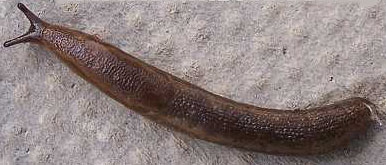
Slugs are common pests during wet weather and can damage many types of plants in the garden. Slugs are fleshy, slimy animals that feed mainly at night. They prefer cool, moist hiding places during the day. They range in color from light gray to black. Cool, wet spring conditions favor slug problems.
Slugs rasp on leaves, stems, flowers and roots. They produce holes in the leaves or just scar the leaf surface. Small seedlings in the garden can be especially vulnerabIe to these creatures. Silvery slime trials are evidence of slug infestations. Here are a few tips on how to prevent or reduce slugs problems:
- Sanitation. Keep the area free of plant debris (leaves, prunings, pulled weeds, etc.), old boards, stones, or tires that provide cool moist hiding places for slugs.
- Prune low branches or trees or shrubs which touch the ground. Rake the leaves or mulch in order to allow the ground to dry.
- Metaldehyde or mesurol bait can be used to kill slugs. Read the label carefully. Do not allow pellets to come in contact with leaves of vegetables.
- Beer traps. Empty cans buried up to the lip and partially filled with beer can be effective slug traps. Beer should be changed every few days to remain effective.
- Barriers of diatomaceous earth, wood ash, lime, sawdust, copper striping, and salt embedded plastic strips can be used around bedded plants.
Some of these tactics are more effective than others. Barriers of diatomaceous earth, sawdust, wood ash, and lime may need to be replaced after each rain. Do not use barriers of salt, this can damage your soil. A combination of two or more of these measures should control your slug problems.
Tree and Shrub Problems - Aphids
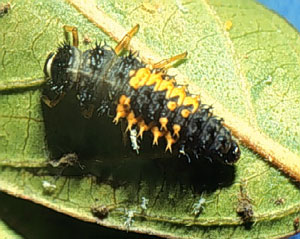
Aphids are common insects, occurring on almost all trees and shrubs in Minnesota. They are most commonly found on rose, ash, oak, maple, willow, and fruit trees. Aphids are small (2-4 mm long), pear-shaped, soft-bodied insects that occur in many colors, including black, green, red, yellow, brown, or gray. They can also be recognized by the presence of cornicles (tailpipes) on their abdomen (see figure). Aphids tend to cluster on unopened flower buds, the underside of young leaves, and developing stems. Woolly aphids also occur on deciduous trees in Minnesota, but are easily distinguished from true aphids by the presence of white, woolly, waxy material (see Yard and Garden Brief Woolly Aphids On Deciduous Trees and Shrubs, E453W).
Aphids have a complex life cycle that sometimes requires two or more different plant species to complete.Aphids usually overwinter as eggs hidden in bark crevices or near buds. Within a week of hatching, aphids, without mating, give birth to live young (nymphs). Aphids produce many young, each of which is capable of reproduction in about a week. As a result, aphid populations can build to enormous levels in a short period of time. Periodically, winged aphids develop and fly to other locations to avoid crowding or to mate. Aphid populations can vary greatly in size through time. A large population one year does not necessarily mean there will be an equally large or larger population the following season.
Aphids suck plant juices through a fine, needle-like stylet and feed on many plant parts. Damage from feeding is quite variable, ranging from no apparent damage to off-color foliage, twisted and curled leaves, gall formation, poor plant growth, and branch dieback. Most healthy, mature trees and shrubs are able to tolerate aphid feeding, even when there are many feeding individuals. However, large aphid populations can significantly weaken recently transplanted or stressed plants.
While aphids often go unnoticed, their waste, called honeydew, is more conspicuous. Honeydew is often described as a "clear, sticky liquid raining from trees." It coats bark, leaves, and objects beneath the plant. Honeydew is easily seen on car windshields and lawn furniture, and can be difficult to remove (see Yard and Garden Brief Removing Sap and Honeydew from Cars, H454R). An unsightly black fungus called sooty mold sometimes grows on honeydew. Sooty mold does not damage the plant, but heavily infected leaves can have a lowered photosynthetic rate. Sooty mold is never treated with chemicals; eliminating honeydew is the best way to control it (see Yard and Garden Brief Sooty Mold, P440S). Honeydew also attracts sweet-feeding ants, that will eat the honeydew and sometimes protect the aphids to maintain the food source. The presence of ants on woody plants can indicate the presence of aphids.
There are several options for aphid management. The first option for aphid management is tolerance, since aphid populations are naturally regulated in many ways. Natural enemies, such as lady beetles, green lacewings, damsel bugs, syrphid flies, parasitic wasps, and certain fungi can all lower aphid populations. Additional natural control is provided by the weather, such as heavy rainfalls. In the absence of these natural controls, aphid numbers can build rapidly. One reason that aphid populations can become very large is that they reproduce much more quickly than their natural enemies, and can quickly rebound from harsh weather. Remember that leaving aphids alone generally causes little damage to the unstressed plant, and has the added benefit of giving natural enemies the chance to exert natural control.
High pressure water spray from a garden hose is also a good option for aphid management on smaller plants. The water spray acts much like a heavy rain, knocking the aphids off the plant.
Insecticides are effective in reducing aphid numbers. It is best to use the least toxic products first. Horticultural oil can be applied in late winter to suffocate aphid eggs, or during the spring and summer to kill nymphs and adults. You can also use insecticidal soap (e.g., Safer's), or the fungus Beauveria bassiana (e.g., Naturalis-O). The fungal spores germinate on the body wall of the aphid, grow through it to the inside, and kill the aphid. The insecticide neem (e.g., BioNeem), made from an extract of the neem tree, is also effective against aphids. These products are examples of 'biorational insecticides' because they kill pests with minimal impact on natural enemies.
Aphids can also be managed with insecticides such as acephate (e.g., Orthene), malathion, diazinon, permethrin, or chlorpyrifos (e.g., Dursban). Keep in mind that these insecticides kill the natural enemies as well as aphids, and can make aphid problems worse. Avoid spraying broad-spectrum insecticides when possible to preserve natural enemies, and to maintain a good long-term strategy for aphid management.
CAUTION: Read all label directions very carefully before purchasing and again before using an insecticide. Information on the label should be used as the final authority.
If you do not want to or cannot attempt to treat an aphid problem yourself, contact a reputable landscape care service. They have considerable experience treating tree and shrub pests.ml
Tree and Shrub Problems - Lace Bugs
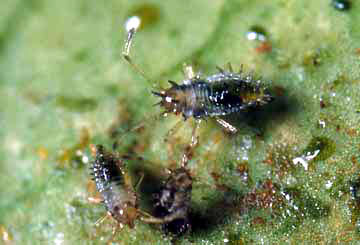
Lace bugs are pests of a wide variety of trees and shrubs. Their hosts include hackberry, walnut, basswood, white oak, bur oak, willow, chokecherry, hawthorn, amelanchier (serviceberry), cotoneasters, and other ornamentals. Lace bugs are 1/8 to 1/4 inch long, have light colored bodies, and elaborate, ornate, lacy wings that look broad and flat from above.
Lace bugs overwinter as adults on or near their host plant. In the spring, adults fly to newly-expanded leaves where they feed and lay black eggs in small groups. The eggs hatch into wingless young called nymphs. The nymphs are dark brown or black and are sometimes covered with long spines. They feed for approximately three weeks before maturing into the winged adults that lay eggs. Normally there are two generations of lace bugs per year.
Lace bugs feed on the undersides of leaves. They insert needle-like mouthparts into leaf tissue, which causes small white or yellow spots on the surface of the leaves. Heavy feeding can cause striking leaf discoloration and early leaf drop. Other signs of lace bugs are dark, varnish-like excrement and shed skins on the undersides of leaves. Lace bug feeding damage is most noticeable in mid to late summer as populations increase.
Lace bug feeding often reduces the aesthetic quality of plants. Lace bugs do not normally threaten the health of woody plants; healthy, mature trees and shrubs can tolerate high populations. However, lace bugs can damage trees and shrubs if heavy feeding occurs over several consecutive years, or if the plants have recently been transplanted or stressed.
An abundance of lace bugs one year does not necessarily mean that the next year's population will be high. Generally, lace bugs are not a problem year after year. If lace bugs are a perennial problem, or if you have plants that have been transplanted or stressed recently, begin monitoring efforts early and manage lace bugs before severe damage occurs.
Management
Tolerate lace bugs when possible. Natural enemies, such as lady beetles, green lacewings, and other predators help keep lace bugs in check. When natural enemies are present, lace bugs generally cause little damage to the plant.
A high-pressure water spray from a garden hose is an option for managing lace bug nymphs on small plants. The water spray acts much like a heavy rain, knocking nymphs off the plant. Since nymphs can not fly back to the plant, they are less likely to survive. Direct the spray at the undersides of the leaves where most lace bugs are found.
Insecticides can be effective in reducing numbers of lace bugs on plants. Use insecticides judiciously, as they kill natural enemies as well as lace bugs, and can make lace bug problems worse. Avoid spraying broad-spectrum insecticides (i.e., acephate, carbaryl, and chlorpyrifos) when possible to preserve natural enemies for good long-term management.
When using insecticides, good coverage is critical. Be sure to spray the undersides of the leaves where lace bugs are normally found.
It is best to use the least toxic products first. Insecticidal soaps (e.g., Safer's), horticultural oils, and pyrethrins are insecticide products with relatively low toxicity, and are relatively safe for many beneficial insects including natural enemies. Other products to manage lace bugs are cyfluthrin, permethrin, carbaryl (e.g., Sevin), or acephate (e.g., Orthene).
CAUTION: Read all label directions very carefully before purchasing and again before using any insecticide. Information on the label should be used as the final authority.
Tree and Shrub Problems - Scale Insects
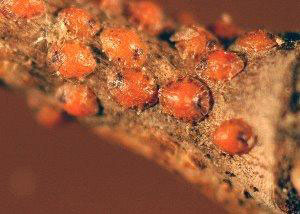
Scale insects are often inconspicuous pests of many evergreen and deciduous plants. They can occur on leaves, twigs, branches or trunks. Their small size and general lack of mobility make them difficult to notice by the casual observer. Scales derive their name from the shell-like, protective covering they form over themselves. Scale insects are broken into two categories:
Soft Scales—generally secrete an attached, thin, waxy layer over themselves. The soft covering they secrete cannot be separated from the scale's body. Soft scales typically move between branches and leaves during their lifecycle. They also produce honeydew.
Armored (Hard) Scales—use shed skins and wax that is unattached to their body to form their hard, shell-like cover. These covers can be separated from the scale's body. Hard scales typically do not move to leaves during their lifecycle and also do not produce honeydew.
Immature scales, upon hatching from eggs, are soft-bodied, mobile and are termed "crawlers." These crawlers seek suitable sites in which to feed, secrete their protective shell, and mature to adulthood. The immobile, "shell stage" of scales are adult females; males are small, fly-like and infrequently seen.
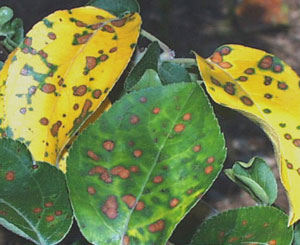
Natural controls (parasitoids, predators, pathogens, environmental conditions) usually maintain scale populations below damaging levels. Also, maintaining healthy, vigorous plants through proper watering, fertilization and pruning (including removing scale-infested branches), will often increase a plant's ability to withstand pest pressure. However, under certain circumstances, scale populations can increase and become injurious. Once scales begin adversely affecting plant health, management measures should be taken.
Scale insects cause damage by removing vital plant fluids from their hosts using their sucking mouth parts. Leaf and needle stunting and yellowing, twig and branch dieback as well as plant death are possible depending on population levels. In some instances, scales weaken plants making them susceptible to damage from secondary pests such as borers or environmental extremes, which may ultimately kill the plant.
Scales can also create nuisance problems by producing a sticky, sweet substance called honeydew, which they secrete while feeding. The stickiness and associated black sooty mold that grows on the honeydew can be an annoyance if cars, patio furniture, decks, etc., are underneath scale-infested trees.
Tree and Shrub Problems - Moths

Adult gypsy moths don’t cause much harm to trees but caterpillars (the immature form of the moth) are another story. Like most caterpillars, gypsy moth caterpillars are ‘eating machines’ whose consume as much as they can, as quickly as they can before they become adults. This caterpillar feeding period lasts seven to ten weeks. Unfortunately for homeowners, gypsy moth caterpillars primarily feed on the leaves of many types of trees and shrubs.
Gypsy moths are capable of feeding on over 500 different species of trees and plants, but they have a particular fondness for oak trees.
Although gypsy moths can exist at relatively low population levels for years at a time, sometimes their populations explode. This occurs for various reasons (favorable weather conditions or a lack of predators, for example). This rapid swelling of population size is called an "outbreak".
Since a single gypsy moth caterpillar can consume 11 square feet or more of vegetation during its lifetime, the presence of thousands or even millions of caterpillars can severely affect trees.
During large outbreaks, trees are virtually stripped of their leaves by hungry caterpillars within a few days. Defoliated trees are left looking as they would in deep winter with bare, leafless branches.

Although most trees will re-grow new leaves (refoliate) before summer’s end, the energy used to accomplish regrowth stresses the tree and drains its reserves.
Weakened trees and shrubs, especially those in urban settings, are more susceptible to attack by opportunistic diseases and organisms such as armillaria root rot and two-lined chestnut borers. In addition, the tree’s growth rate is impaired, which affects its chances for survival during the following years. If a tree loses more than 50% of its leaves (for any reason) for more than two years in a row, it will certainly be weakened and may not survive.
Tree and Shrub Problems - Leaf Miners
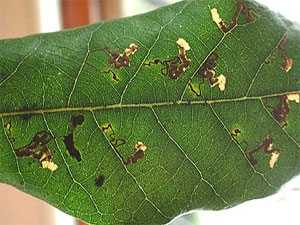

Leaf miners (Argyresthia cupressella) attack both arborvitae and junipers. The miner tunnels into the growing tip and kills it. Heavy infestation can make the entire plant look brown and dead. The adult is a moth. It is a silvery tan and is out only in the spring and early summer. Eggs are laid on the branch tips that are one or two years of age. Upon hatching the larvae tunnel into the leaf scales and mines/tunnels until winter or even the following spring. During the growing season, little damage is noticed. Not until winter when a yellowing of the leaf scales followed by browning is any noticeable damage visible. The dead twigs frequently break off easily due to their dried out condition. Once the larvae are finished feeding, they leave the mine and spin a cocoon (pupae stage) in the dead or still living foliage. Weeks later, adults emerge, mate and lay eggs to start another cycle of feeding. Control
Rarely are leafminer numbers high enough to warrant control on arborvitae or junipers. If numbers are high, insecticides applied in mid-spring and repeated two weeks later should be effective.
Tree and Shrub Problems - Borers

Insect borers can be serious aesthetic, economic, and structural pests of trees and shrubs. Their tunneling damages wood, creates "hazard" trees, and lowers the wood's value for lumber and veneer. Infested nursery stock may have poor form, reduced growth rates, or be impossible to sell.
Borer larvae (immatures) and adults make tunnels in the shoots, branches, trunks, or roots of woody plants of all ages and sizes. Eggs of most borer species are laid on or in the bark, and larvae chew into the plant tissue. Most borers are larvae of beetles or moths, but some are wasps or flies. Most insect borers are considered "secondary pests" because they attack only after a plant has been weakened or killed by another stress. Some, however, are "primary pests" and are able to attack and develop in fairly healthy trees and shrubs. Knowing whether insects are primary or secondary pests is critical to assessing and treating plant problems.
Damage
The presence of borers is hard to detect until plants or plant parts become damaged or die. Sawdust-like frass (excrement) may be around an exit hole or in a pile on the ground. Sap may ooze from the wounded site. There may be round, oval, or D-shaped holes randomly located on the plant. Insect exit holes can be distinguished from woodpecker holes by the absence of frass. The chewing of some species may be heard by someone standing near the tree.
The severity of plant damage depends on the number and location of insects in the plant tissue. Phloem feeders destroy tissues that transport food and produce new wood and bark. Feeding by a few individuals may produce necrotic lesions, whereas feeding that encircles the stem may kill a branch or the entire tree. Xylem borers make holes in the sapwood that disrupt the flow of nutrients and water as well as structurally weakening the plant. Twig and shoot borers decrease fruit, nut, and seed production by causing branch dieback. Borers may also feed in the succulent callus tissue around grafts, thus preventing the connection of scion and stock. Dead branches, pitch masses, and wood and bark riddled with holes decrease the aesthetic value of plants.
Prevention
Keeping plants healthy can minimize damage from secondary pests like insect borers.
Avoid other physical injury or stress to tree trunks or roots (e.g., lawn mowers, weed trimmers, digging building foundations, septic tanks, soil compaction, soil added or removed above the roots, drought, flooding, or lightening). Mulch around the trunk to increase the distance between machinery and the plant.
Because many borers are attracted to recent wounds, avoid pruning during adult activity periods.
Place trees and shrubs in properly prepared areas protected from extreme weather conditions.
Follow recommended irrigation and fertilization guidelines.
Non-Chemical Control
After trees and shrubs are infested with borers, non-chemical controls are limited.
Remove and destroy (burn or chip) infested, dying or dead plants or plant parts, including fallen limbs. Severely infested trees ("brood trees") only produce more pests that can attack neighboring trees.
Several natural enemies attack insect borers, including predatory beetles, parasitic wasps or flies, and birds, especially woodpeckers.
Insert a flexible, small gauge wire into borer entry holes to puncture and kill the tunneling insect. Several attempts may be needed to be successful.
Use pheromone traps to monitor adult activity, and disrupt the mating and egg-laying of clearwing borers. These traps often only attract males.
Use ultraviolet blacklight traps to monitor adult beetles, which are drawn to the light and die in the bucket. These traps attract both males and females.
Chemical Control
Stressed, unhealthy trees may be repeatedly attacked and need repeated insecticide treatments. This is often expensive and not environmentally friendly. The first priority is to improve overall tree health, and use insecticides as a last resort. In addition, most chemicals can only be obtained and applied by licensed professionals with specialized equipment.
Insecticide products registered for borer control are listed in Table 1 . Most of these products are applied as sprays to the trunks and branches, and are contact, residual insecticides (e.g., carbaryl, chlorpyrifos, lindane, permethrin). While these products do not kill larvae that have already penetrated the sapwood or heartwood, they will kill adults and larvae tunneling through the treated bark layer. These products are applied preventively and may be effective for 3 to 10 weeks.
Complete spray coverage of all trunk and branch surfaces is necessary for preventive control of borers. Treating only the base of the tree trunk is enough to protect the tree only from a few insects such as the black turpentine beetle and the peachtree borer. Thorough coverage may be difficult on large trees and may result in drift to non-target areas. To minimize drift, spray only on non-windy days. Read the insecticide lable for the proper protective clothing requirements.
Systemic insecticides are often ineffective for borer control and few are labeled for this purpose. Systemics may be applied as foliar sprays, root drenches, or trunk injections. Trunk injections work by delivering pressurized and concentrated insecticides into the tree ( Figure 9 ). However, these injections are most effective against sap-feeding insects and rarely affect woodborer larvae. The process of injecting the insecticide through a narrow tube and into the drilled hole may result in sap staining, and could allow pathogens an entry point. Translocation of the insecticide is unlikely in partially girdled areas. The use of these products has not been studied in Florida.
Tree and Shrub Problems - Beetles
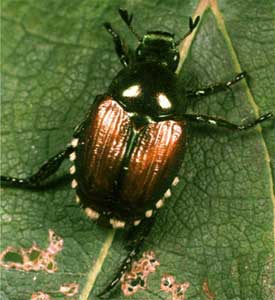
Japanese beetles feed on over 200 kinds of plants. Some of the favorites include linden, maples, crabapple, elm, grape, and roses, among others. Feeding beetles skeletonize leaves, feeding on the leaf tissue between the veins. The remaining leaf turns brown and may drop. Usually the upper portions of plants are damaged first because the beetles like warmth and sunshine. Aesthetic quality of the plant is reduced and it is subject to more stress as a result of the beetle feeding.
Adult beetles are usually out for about six weeks, which means most should be gone by mid-August. After mating, beetles lay their eggs in the soil. Eggs hatch into grubs that may feed on various plant or turfgrass roots. Thus it is possible for lawns to be damaged later this summer by the grubs. Japanese beetles overwinter as grubs in the soil, and emerge as adults again next June to start the cycle over again.
Actively feeding beetles can be controlled using carbaryl (Sevin). Repeat the application at about weekly intervals. Treatment is generally suggested for smaller plants, or perhaps those near entrances or other key landscape locations. Treating large trees is rarely suggested. Also, research has shown Japanese beetle traps to be ineffective, and may actually draw more beetles into the area.
Automatically treating lawns in areas where the beetles currently are feeding is not suggested. Only treat lawns for grubs if in fact grubs become a problem in the lawn. You may see adult beetles now on trees and shrubs but no lawn damage from grubs later this summer. And even if you were to kill all the grubs in the soil, there is no guarantee more beetles still don't appear next season on your trees and shrubs, as they fly in from other areas.
Tree and Shrub Problems - Caterpillars
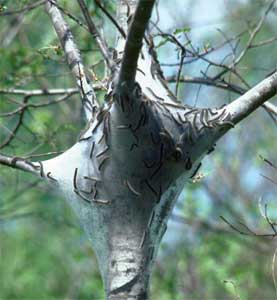
Defoliating caterpillars either partially or completely consume the leaves or needles of their host plants, and in some cases may also feed on flowers, buds, and young shoots. Some species fold or roll leaves together with silk, and others make silken nests or tents for shelter. Others may chew holes in leaves, feed selectively between the leaf veins, or feed on only one surface of the leaf (window feeders). Specialized feeders called "leafminers" feed between the leaf tissue layers. The importance of the injury depends on plant age, species, health, length of infestation, and the value (e.g., aesthetic, ecological, commercial) ascribed to the tree or shrub. Undesired gaps in the foliage, reduced growth, or death may result from several years of repeated, heavy defoliation. Complete defoliation may cause some plants to produce new leaves. If that new growth flush occurs very early or late in the growing season, it may be more susceptible to freeze injury. However, otherwise healthy and mature trees can tolerate extensive caterpillar feeding without mortality or substantial growth loss, particularly when the infestation is short-lived.
Identification and Biology
Adult moths or butterflies mate, then females lay eggs singly or in masses on or near larval food plants. The eggs usually hatch after several days. The larvae move individually or in groups to feeding sites on a plant. As they feed and grow, they molt or shed their skins several times before pupating. Some larvae pupate directly on the host plant, but others may pupate on fences, tree trunks, in the leaf litter beneath a tree, or in other hidden and undisturbed areas. The adult moth or butterfly emerges from the pupal case or cocoon after several more days, weeks, or months, depending on the species. Moths tend to fly at night, butterflies are usually active during the day, and both tend to feed on nectar and water. Adults are not damaging to plants. Some species in Florida have only one generation a year (e.g., eastern and forest tent caterpillar, hickory horned devil), whereas others may have multiple generations a year (e.g., fall webworm, oleander caterpillar, palm leaf skeletonizer). Caterpillar populations naturally fluctuate between periods of high and low abundance.
Caterpillars can be distinguished from sawfly, beetle, or fly larvae by the number and arrangement of their legs. Caterpillars, beetle larvae, and sawfly larvae have three pairs of true legs, one pair on each thoracic segment. Sawfly larvae also have six or more pairs of fleshy leglike appendages (called prolegs) on their abdominal segments . Caterpillars have prolegs on some abdominal segments, but never have more than five pairs. Unlike sawflies, caterpillars have small hooked spines called crochets at the end of their prolegs. Beetle larvae have true legs, but lack prolegs. Fly larvae are legless.
Monitoring
Damage can be minimized if infestations are seen while caterpillars are still young. Know which plants tend to get reinfested or are prone to certain pests. Some caterpillars feed on top, underneath, within, or along the edge of leaves, and many blend in with the plant coloration, mimic bird droppings, or encase themselves with plant debris. Look for fecal pellets (frass) on or below plants, on picnic tables, vehicles, and sidewalks. The pellets get bigger as the insects grow. A lot of pellets may indicate a large caterpillar infestation. You can also monitor for egg masses, webbing, pupal cases, cocoons, or signs of natural enemies. Avoid touching caterpillars with spines or hairs - some species can cause a burning sensation or an allergic rash on exposed skin.
Management
Knowing the insect's species and life cycle is important when trying to decide if control is needed. If the insect only has one generation a year, then it may be prudent to just wait it out until the larvae disappear (e.g., pupate).
Cultural and Physical Control
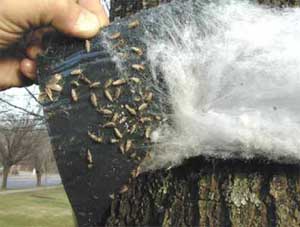
Keep plants healthy with proper irrigation and fertilization. Moths that fly at night are attracted to lights, so either turn exterior lights off or use sodium vapor instead of mercury vapor light bulbs. Prune silken tents out of branches before they get too large. Nest-feeding caterpillars tend to remain in their shelters on cool, overcast or rainy days, so pruning may be most effective at those times. Hand-pick caterpillars from plants and remove or destroy them. Look for egg masses and scrape them off into soapy water and dispose of them.
Biological Control
Predators, parasitoids, and natural disease outbreaks, in combination with environmental factors, usually return caterpillar populations to non-damaging levels. Predators include some stink bugs, assassin bugs, bigeyed bugs, damsel bugs, ground beetles, pirate bugs, spiders, and birds. Mice and other small animals feed on pupae that are on or near the ground. Eggs are often parasitized by tiny wasps, and larvae may be killed by larger wasps or tachinid flies. Some caterpillars die from diseases caused by naturally-occurring bacteria, fungi, or viruses. Those killed by viruses or bacteria may turn dark, their bodies may become limp, soft, and smelly. When those bodies rupture, more viral particles or bacterial spores are released and infect other caterpillars that eat the contaminated foliage.
Microbial Insecticides
The most environmentally-friendly treatment against young caterpillars is a commercially available pathogen, Bacillus thuringiensis (Bt) variety kurstaki. Other varieties or subspecies of Bt are not effective on caterpillars. When infected with Bt, young caterpillars stop feeding within a day and usually die within a few days. Bt is not harmful to beneficials. Applications are most effective on warm, sunny days, when caterpillars are exposed and actively feeding (the Bt pathogen works only by ingestion). Because of the short residual, Bt should be reapplied about 7-10 days later, if needed. Another commercially available microbial product that is specific to caterpillars is Conserve (active ingredient: spinosad).
Reduced-Risk Insecticides
Other products that are effective at controlling caterpillars include growth-regulating products that inhibit the caterpillar molting process, such as azadirachtin (Azatin), diflubenzuron (Dimilin) and tebufenozide (Confirm T&O). For leafminers, an insecticide that can be absorbed into the leaf tissue, such as acephate (Orthene) may be most effective. For best results, time these applications to coincide with newly hatched larvae. For insects with multiple generations per year, target larvae during the first generation, when there is less overlapping of life stages within the population. Broad-spectrum insecticides like pyrethroids (e.g., Talstar, Tempo) or carbamates (e.g., Sevin) can be used if older larvae have been found and insect growth regulators or microbials are less effective. However, broad-spectrum insecticides will likely kill any natural enemies present, and could cause an outbreak of mites, scales, or other pests on some plants.
Tree and Shrub Problems - Black Vine Weevil
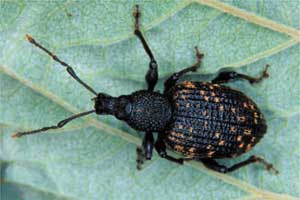
The black vine weevil is a pest of several ornamental trees and shrubs, including taxus, hemlock, rhododendron, euonymus, azalea and andromeda as well as many herbaceous plants in nurseries and in the home landscape planting. Occasionally it is brought indoors with, and feeds on roots of houseplants that spent the summer out of doors near shrubs.
The most severe damage is caused by the grubs (larval stage) which feed on the feeder roots and cortex of larger ones, and may girdle the root crown. The above-ground symptoms are of general plant unthriftiness including stunting and yellowing or off-color foliage. Root feeding often results in death of the plant and it is at this late stage of injury that home gardeners often notice the problem. Plants may fail to put out new growth in the spring as a result of the root injury, or may put out the first flush of new growth, and subsequently die. Adult weevils feed on foliage, chewing out characteristic notches, and while foliar damage is often not serious, it can be unsightly. Adults are occasionally found indoors during the winter months. A few do overwinter and seek shelter near foundations and occasionally wander inside. They are a nuisance to find, but a threat only to actively growing plants in the house. Removing by hand when seen is the best control for a few individuals inside the home.
DESCRIPTION
The adult is a black wingless weevil (snout beetle) about 3/8 inch (10 mm) long. All of the weevils are females and they reproduce parthenogenetically. Since the weevils do not fly, they disperse chiefly by walking, although they may be transported by man with infested plant material. The grub is a legless, white (with a brown head) larva with a wrinkled c-shaped appearance and is found in the soil under host plants.
LIFE HISTORY
There is one generation of the black vine weevil each year. Adults usually emerge between mid-May and late July and live for several months. Adults may overwinter and be found in early spring. The weevils feed at night and hide under leaf litter or in the soil during the day. When disturbed, the adults feign death. After 3-4 weeks of feeding the females begin to deposit eggs. Eggs are dropped indiscriminately to the ground under the plants (as many as 500 per female!) over their entire life. If houseplants are placed under shrubs during the summer, eggs may be deposited on the soil of the containers. Ten to 14 days later the grubs hatch and burrow down into the soil searching out roots to feed on.
Larval feeding occurs through the growing season but when colder temperatures arrive, grubs burrow deeper in the ground to overwinter. They resume feeding the following spring for a short while before they enter the pupal stage. Pupation lasts about 1 month and adults are most abundant from early June to mid-July.
MANAGEMENT
Look for symptoms (monitor plantings) of feeding injury by adults, and/or use a flashlight at night (adults are nocturnal) during early to mid-June to inspect plants for the presence of weevils. Injury will be easy to see on broad leaved evergreens such as rhododendron, but may be hard to find on Taxus. Weevils may be feeding on leaf edges, especially near the trunk. Pit fall traps or beating sheets are sometimes used to monitor adult activity. Where possible, quarantine plants with leaf notches.

Treat for the adults before egg laying can occur (2 to 3 weeks after emergence). The insecticide acephate (Orthene) is recommended for the control of black vine weevil adults on Taxus, Rhododendron and other ornamental plants. Two applications should be made, one 3 weeks after adults are first seen (or in mid-June) and a second 3 weeks later. Insecticide applications should be made late in the day (weevils are nocturnal feeders). Be sure to follow the label directions when using any pesticide.
If houseplant roots are found to be infested with larvae, discarding the plant may be the best practice. One might try washing off the roots and repotting, but success will depend on the amount of damage already done (often too late by the time one notices it).
Tree and Shrub Problems - Bag Worm
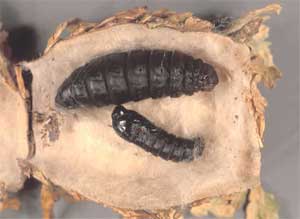
Bagworms feed on many species of trees and shrubs, but are most common on junipers. Newly hatched larvae begin to spin a silken bag around themselves shortly after hatching. The first evidence of infestation is the presence of 1/4 inch bags which are carried almost on end by the young caterpillars inside. As larvae grow, leaf fragments are added to the bag, which may reach a length of two inches by the end of summer.
Bagworms overwinter in the egg stage inside female bags fastened to twigs. Eggs hatch in late May and early June, and larvae feed until late August or early September. Males emerge in September and mate with females through the bag entrance.
Control infestations on small trees and shrubs by removing bags during the winter and spring before the eggs begin to hatch in late May. Destroy bags by burning, immersing in kerosene or by crushing. If bags containing larvae are discarded on the ground the larvae can return to host plants.
Chemical control are effective if applied during early stages of bagworm development. For most effective insecticidal control and prevention of damage, apply sprays from mid to late June. Treatment later is often ineffective since the bag will provide protection from the insecticide. Some of the insecticides registered for control of bagworms on ornamentals include Bacillus thurnigiensis (Dipel), Sevin, diazinon, malathion and others.
Tree and Shrub Problems - Frost Damage

The ideal time to assess winter injury to trees and shrubs is after new growth begins to emerge in the spring. Some injuries may not show symptoms until later in the growing season, which can make correct diagnosis difficult. Many plants have protective mechanisms that should not be confused with winter damage. For example, some plants will shed leaves (Nandina and Privet); some plants will roll their leaves downward or the margins inward (Rhododendron); some evergreens (Juniper, Arborvitae, Cryptomeria, and Boxwood) turn a red, purple or bronze color.
Winter injury can occur in many different forms, including low temperature/frost injury, winter desiccation, winter sunscald, frost cracks, snow & ice breakage and rodent damage. Damage symptoms include discolored needles or leaves, dead branches or branch tips, heaved root systems, broken branches or girdled stems.
Low temperature injury can occur during the winter season when unusually warm weather in autumn delays dormancy and is then followed by early frost or drastic temperature fluctuations. Injury can also occur in early spring when new growth emerges, followed by abnormally low temperatures. Symptoms of low temperature injury are foliar browning and dieback of buds, twigs and branches. Plants will often leaf out, then collapse due to damaged cell tissue in the vascular system.
Reducing the occurrence of winter injury can be accomplished by following some guidelines. Be sure to select hardy plants. Growing plants that are winter hardy or native will reduce the effects of low temperature/frost injury. Avoid fertilizing plants with high nitrogen late in the summer so new growth is not promoted. Injury to young growth or insufficiently hardened tissues may still occur as a result of unusual weather patterns. Injured and dead tissues should be pruned out to discourage invasion of the plants by diseases and/or insects.
Winter desiccation or 'winter burn' is usually observed in late winter or early spring on evergreen plants. Broadleaved evergreens, such as rhododendron, exhibit browning on their leaf margins. Narrow leaved evergreens can exhibit slight browning of needle tips to browning and premature abscission of entire needles, depending on the extent of the injury. Winter desiccation occurs more drastically on sunny and/or windy winter days when plants lose water from their leaves through transpiration faster than it can be replaced by the roots frozen in the soil.
To prevent or reduce the effects of winter desiccation, make sure plants are properly watered during dry periods in the autumn. Thoroughly hydrated plants are less susceptible. Placing a protective barrier of burlap around small evergreens will act as a windbreak and reduce the rate of desiccation. The barrier can also shade the plant, avoiding warming by the sun. Antidessicant sprays applied to evergreens may reduce water loss. Follow label directions for use. Research results are mixed on whether or not antidessicants are effective.
Winter sunscald usually occurs on the south or southwest sides of tree trunks and branches. Young and thin-barked trees are most susceptible. The bright winter sun warms the bark during the day. The bark cools rapidly after sunset causing injury and even death to the inner bark in those areas. Symptoms of winter sunscald are elongated, sunken dead areas in the bark.
Wrapping the trunks of susceptible trees with tree wrap is the most effective way to minimize this type of winter injury. If a tree wrap is used, it should be removed after one season to prevent insect or moisture damage. In commercial orchards, it is customary to paint the trunks of trees white to reflect the winter sun, reducing the buildup of heat during the day.
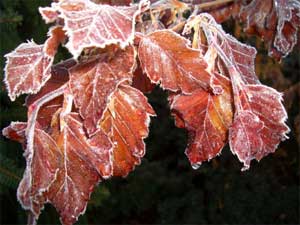
Frost cracks are splits in the bark and wood of a tree. They are caused by rapid drops in temperature that freeze the water within the trunk, forcing it to explode or split open. If not severe, the cracks can heal themselves by callusing over. However, many times the cracks reopen again the following winter. Frost cracks can be compounded by internal defects within the wood. Defective wood does not contract as readily as the outer layers of healthy wood when winter temperatures decrease rapidly.
Care should be taken to avoid trunk damage of trees, especially when young. Frost cracks in trees are ideal entrance sites for wood decaying organisms and insects.
Heavy snow or ice on weak branches with foliage can result in breakage. Evergreens are especially susceptible. Sometimes even strong branches from deciduous trees can be broken if the weight of ice or snow is extremely heavy.
Properly pruned trees and shrubs can reduce the accumulation of snow and ice collected on the branches. Removal of weak branches and those with acute or narrow angles can help reduce breakage. Avoid late-summer pruning that stimulates new growth.
Winter injury can be reduced by following the management tips provided. Injury can occur on a broad range of evergreen and deciduous plants and symptoms may vary. Be a careful observer and ask various questions to assist with diagnosing winter injuries to plants.
Tree and Shrub Problems - Snail

Snails and slugs are among the most bothersome pests in many garden and landscape situations.
Several species of slugs are frequently damaging, including the gray garden slug (Agriolimax reticulatus), the banded slug (Limax marginatusi), the tawny slug (Limax flavus), and the greenhouse slug (Milax gagates). Both snails and slugs are members of the mollusk phylum and are similar in structure and biology, except slugs lack the snail’s external spiral shell.
IDENTIFICATION AND BIOLOGY
Snails and slugs move by gliding along on a muscular "foot." This muscle constantly secretes mucus, which later dries to form the silvery "slime trail" that signals the presence of either pest. Slugs and snails are hermaphrodites, so all have the potential to lay eggs. Adult brown garden snails lay about 80 spherical, pearly white eggs at a time into a hole in the topsoil. They may lay eggs up to six times a year. It takes about 2 years for snails to mature. Slugs reach maturity after about 3 to 6 months, depending on species, and lay clear oval to round eggs in batches of 3 to 40 under leaves, in soil cracks, and in other protected areas.
Snails and slugs are most active at night and on cloudy or foggy days. On sunny days they seek hiding places out of the heat and bright light; often the only clues to their presence are their silvery trails and plant damage. In mild-winter areas such as southern coastal locations, young snails and slugs can be active throughout the year.
During cold weather, snails and slugs hibernate in the topsoil. During hot, dry periods or when it is cold, snails seal themselves off with a parchmentlike membrane and often attach themselves to tree trunks, fences, or walls.
DAMAGE
Snails and slugs feed on a variety of living plants as well as on decaying plant matter. On plants they chew irregular holes with smooth edges in leaves and flowers and can clip succulent plant parts. They can also chew fruit and young plant bark. Because they prefer succulent foliage or flowers, they are primarily pests of seedlings and herbaceous plants, but they are also serious pests of ripening fruits, such as strawberries, artichokes, and tomatoes, that are close to the ground. However, they will also feed on foliage and fruit of some trees; citrus are especially susceptible to damage. Look for the silvery mucous trails to confirm damage was caused by slugs or snails and not earwigs, caterpillars, or other chewing insects.
MANAGEMENT

A good snail and slug management program relies on a combination of methods. The first step is to eliminate, to the extent possible, all places where snails or slugs can hide during the day. Boards, stones, debris, weedy areas around tree trunks, leafy branches growing close to the ground, and dense ground covers such as ivy are ideal sheltering spots. There will be shelters that are not possible to eliminate—e.g., low ledges on fences, the undersides of wooden decks, and water meter boxes. Make a regular practice of trapping and removing snails and slugs in these areas. Also, locate vegetable gardens or susceptible plants as far away as possible from these areas. Reducing hiding places allows fewer snails and slugs to survive. The survivors congregate in the remaining shelters, where they can more easily be located and removed. Switching from sprinkler irrigation to drip irrigation will reduce humidity and moist surfaces, making the habitat less favorable for these pests. Choose snail-proof plants for areas where snails and slugs are dense. Copper barriers can be useful for protecting especially susceptible plants. Though baits can be part of a management program for snails and slugs, by themselves they don’t provide adequate control in gardens that contain plenty of shelter, food, and moisture.
Choice of plant can greatly affect how difficult your battle with snails and slugs will be. Snails and slugs favor seedlings and plants with succulent foliage and these plants must be vigilantly protected. Some plants that are seriously damaged include basil, beans, cabbage, dahlia, delphinium, hosta, lettuce, marigolds, strawberries, and many vegetable plants. On the other hand, many plants resist damage from snails and slugs including begonias, California poppy, fuchias, geraniums, impatiens, lantana, nasturtiums, and purple robe cup flower, and many plants with stiff leaves and highly scented foliage like lavender, rosemary, and sage. Most ornamental woody plants and ornamental grasses are also not seriously affected. If you design your landscape using plants like these, you are likely to have very limited damage from snails and slugs.
Handpicking
Handpicking can be very effective if done thoroughly on a regular basis. At first it should be done daily. After the population has noticeably declined, a weekly handpicking may be sufficient. To draw out snails, water the infested area in the late afternoon. After dark, search them out using a flashlight, pick them up (rubber gloves are handy when slugs are involved), place them in a plastic bag, and dispose of them in the trash; or they can be put in a bucket with soapy water and then disposed of in your compost pile. Alternatively, captured snails and slugs can be crushed and left in the garden. Household ammonia diluted to a 5 to 10% solution in water can also be sprayed on collected slugs to kill them.
Traps
Snails and slugs can be trapped under boards or flower pots positioned throughout the garden and landscape. Inverted melon rinds make good traps. You can make traps from 12" x 15" boards (or any easy-to-handle size) raised off the ground by 1-inch runners. The runners make it easy for the pests to crawl underneath. Scrape off the accumulated snails and slugs daily and destroy them. Crushing is the most common method of destruction. Do not use salt to destroy snails and slugs; it will increase soil salinity.
Beer-baited traps have been used to trap and drown slugs and snails; however, they are not very effective for the labor involved. Beer traps attract slugs and snails within an area of only a few feet, and must be refilled every few days to keep the level deep enough to drown the mollusks. Traps are buried at ground level, so the mollusks easily fall into them. It is the fermented product that attracts them and a sugar-water and yeast mixture can be used in place of beer. Traps must have deep, vertical sides to keep the snails and slugs from crawling out and a top to reduce evaporation. Snail and slug traps can also be purchased at garden supply stores.
Barriers
Several types of barriers will keep snails and slugs out of planting beds. The easiest to maintain are those made with copper flashing and screen. Copper barriers are effective because it is thought that the copper reacts with the slime that the snail or slug secretes, causing a flow of electricity. Vertical copper screens can be erected around planting beds. The screen should be 6 inches tall and buried several inches below the soil to prevent slugs from crawling through the soil beneath the barrier.
Copper foil (for example, Snail-Barr) can be wrapped around planting boxes, headers, or trunks to repel snails for several years. When banding trunks, wrap the copper foil around the trunk, tab side down, and cut it to allow an 8-inch overlap. Attach one end or the middle of the band to the trunk with one staple oriented parallel to the trunk. Overlap and fasten the ends with one or two large paper clips to allow the copper band to slide as the trunk grows. Bend the tabs out at a 90° angle from the trunk. The bands need to be cleaned occasionally with a vinegar solution. When using copper bands on planter boxes, be sure the soil within the boxes is snail-free before applying bands. If it is not, handpick the snails and slugs from the soil after applying the band until the box is free of these pests.
Instead of copper bands, Bordeaux mixture (a copper sulfate and hydrated lime mixture) or copper sulfate alone can be brushed on trunks to repel snails. One treatment should last about a year. Adding a commercial spreader or white latex paint may increase the persistence of Bordeaux mixture through two seasons. Barriers of dry ashes or diatomaceous earth, heaped in a band 1 inch high and 3 inches wide around the garden, have also been shown to be effective. However, these barriers lose their effectiveness after becoming damp and are therefore difficult to maintain and not very useful in most garden situations.
Natural Enemies
Snails and slugs have many natural enemies, including ground beetles, pathogens, snakes, toads, turtles, and birds, but most are rarely effective enough to provide satisfactory control in the garden. An exception is the use of domesticated fowl—ducks, geese, or chickens—kept penned in infested areas. (Be careful, though, as these birds may also eat seedlings.) The predaceous decollate snail (Rumina decollata) has been released in southern California citrus orchards for control of the brown garden snail and is providing very effective biological control. It feeds only on small snails, not full-sized ones. Because of the potential impact of the decollate snail on certain endangered mollusk species, it cannot be released in California outside of Fresno, Imperial, Kern, Los Angeles, Madera, Orange, Riverside, Santa Barbara, San Bernardino, San Diego, Ventura, or Tulare counties. Also, decollate snails may feed on seedlings, small plants, and flowers as well as be a nuisance when they cover the back patio on a misty day. Decollate snails will be killed by snail baits.
Baits
Snail and slug baits can be effective when used properly in conjunction with a cultural program incorporating the other methods discussed above. However, baits alone will not effectively control snails or slugs. Several types of snail and slug bait products are available. Baits containing the active ingredient metaldehyde are most common. Metaldehyde baits are particularly poisonous to dogs and cats, and the pelleted form is especially attractive to dogs. Metaldehyde snail baits should not be used where children and pets cannot be kept away from them. Some metaldehyde products are formulated with carbaryl, partly to increase the spectrum of pests controlled to include soil and debris-dwelling insects, spiders, and sowbugs. However, carbaryl is toxic to soil-inhabiting beneficials like ground beetles and earthworms and should be avoided if snail and slug management is all that is required. Metaldehyde baits containing 4% metaldehyde are significantly more effective than those products containing only 2% metaldehyde; however, they are also more toxic to dogs and wildlife. Most currently available 4% products are formulated for use in enclosed bait stations to minimize their hazard.
Avoid getting metaldehyde bait on plants, especially vegetables. Baits containing only metaldehyde are most reliable when temperatures are warm or following a rain when snails and slugs are active. Metaldehyde does not kill snails and slugs directly unless they eat a substantial amount; rather, it stimulates their mucous-producing cells to overproduce mucous in an attempt to detoxify the bait. The cells eventually fail and the snail dies. When it is sunny or hot, they die from desiccation. If baiting is followed by cool and wet weather, they may recover if they ingest a sublethal dose. Do not water heavily for at least 3 or 4 days after bait placement; watering will reduce effectiveness and snails may recover from metaldehyde poisoning if high moisture conditions occur. Most metaldehyde baits break down rapidly when exposed to sunlight; however, some paste or bullet formulations (such as Deadline) hold up somewhat longer under conditions of sunlight and moisture.
A recently registered snail and slug bait, iron phosphate (available under many trade names including Sluggo and Escar-Go), has the advantage of being safe for use around domestic animals, children, birds, fish, and other wildlife and is a good choice for a garden IPM program. Ingestion of the iron phosphate bait, even in small amounts, will cause snails and slugs to cease feeding, although it may take several days for the snails to die. Iron phosphate bait can be scattered on lawns or on the soil around any vegetables, ornamentals, or fruit trees to be protected. Iron phosphate baits may be more effective against snails than slugs.
Sprinkle baits in areas that snails and slugs regularly frequent such as areas around sprinkler heads. Placing baits repeatedly in the same areas maximizes control because molluscs tend to return to food source sites. Never pile bait in mounds or clumps, especially those baits that are hazardous, because piling makes a bait attractive to pets and children. Placement of the bait in a commercial bait trap reduces hazards to pets and children and can protect baits from moisture, but may also reduce their effectiveness. Thick liquid baits may persist better under conditions of rain and sprinklers.
The timing of any baiting is critical; baiting is less effective during very hot, very dry, or cold times of the year because snails and slugs are less active during these periods. Irrigate before applying a bait to promote snail activity and apply the bait in the late afternoon or evening. Application on a warm, humid evening is ideal. Apply bait in a narrow strip around sprinklers, close to walls and fences or in other moist and protected locations, or scatter it along areas that snails and slugs cross to get from sheltered areas to the garden.
Tree and Shrub Problems - Cicada
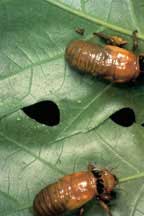
After spending nearly two decades living in underground tunnels sucking sap from the roots of trees and shrubs, millions of cicadas emerged from the ground in May and June.
In their few weeks above ground, periodical cicadas mate, lay their eggs, and then die.
Although they have a unique appearance-adult cicadas are one and one-half to two inches long and black with orange or orange-brown body stripes and red eyes and legs-the periodical cicada is best known for its incessant high-pitched droning, a sound many find annoying or even unbearable.
The males of the species are the culprits. Females are voiceless. Morning to night, the males produce five different mating sounds, the most common one sounding like "farro." Another common noise produced by the insects is a whirring sound.
Although the females don't make any noise, they make their mark with the damage they inflict on twigs and small branches. The female cicadas make egg-laying slits or punctures on branches and twigs. Twigs with a multitude of slits are often broken or partially broken from the branches.
More than 250 species of trees and shrubs are subject to attack by the egg-laying female. However, she seems to prefer oak, maple, apple, dogwood, and nut trees. Lone fruit trees or seedlings less than a foot tall are most vulnerable. Mature forest trees usually can withstand this temporary harm because the cicada finds many twigs in forests in which to deposit eggs.
If cicadas have damaged your trees, prune them. Cut out, as far as is practical, the badly-damaged twigs and branches. With fertilization, you can stimulate these trees to a rapid, vigorous growth so that the wounded places will heal more rapidly.
Cicada Facts and Fantasy

The North American periodical cicada is not a locust. The Pilgrims dubbed the cicada a "locust" when it first appeared to them at Plymouth, Massachusetts, in 1634. The insect undoubtedly reminded them of the migratory locust, a species of grasshopper that ruined crops in Egypt in Biblical times and still is a threat to crops in many parts of the world.
Stories about the sting of the cicada are false-the insect has no stinger. People sometimes mistake the vibrations of the wings or the sharpness of the feet as a sting. Likewise, it is a myth that fruit is poisoned if "stung" by a cicada.
The dark bars on the cicada's filmy wings resemble a "W." To the superstitious, their appearance suggests that war is imminent.
*We at ACE believe that our program is sufficient enough to control most of your tree and shrub problems. Nevertheless, the service is not fully guaranteed since we can't be responsible for the surrounding areas.
15% discount if pre-paid for any program before April 15
for 6 lawn and/or shrub applications